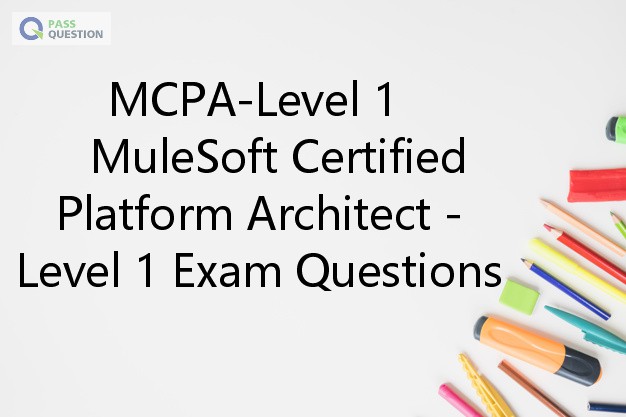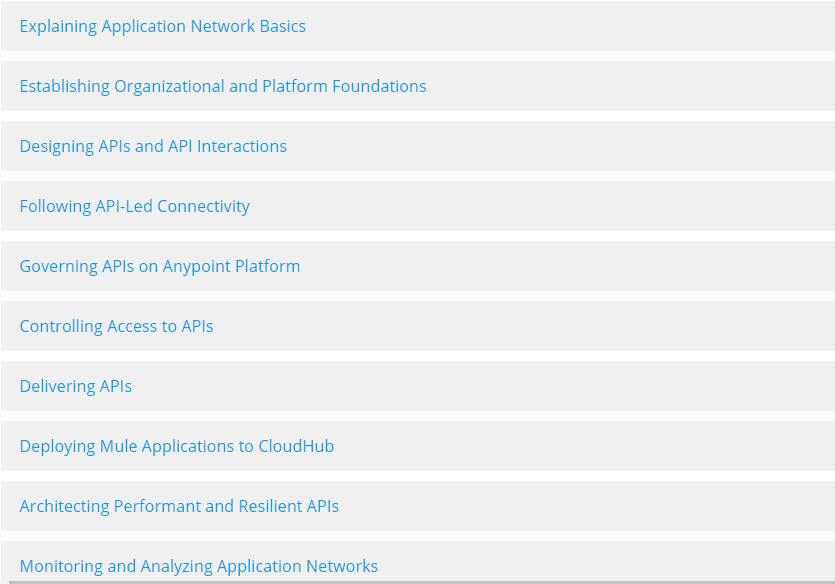MCPA-Level 1 MuleSoft Certified Platform Architect - Level 1 Exam Questions
Want to pass MuleSoft Certified Platform Architect - Level 1 Exam? PassQuestions new updated MCPA-Level 1 MuleSoft Certified Platform Architect - Level 1 Exam Questions which include the latest and most accurate information about MuleSoft Certified Platform Architect - Level 1 exam.It ensure you have a good preparation for your exam and help you pass your MCPA-Level 1 certification exam successfully in your first attempt.

What Is MuleSoft Certified Platform Architect - Level 1?
The MuleSoft Certified Platform Architect - Level 1 exam validates that an architect has the required knowledge and skills to direct the emergence of an effective application network out of individual integration solutions following API-led connectivity across an organization using Anypoint Platform. S/he should be able to:
- Optimize and shape the Anypoint Platform deployment in the specific organizational context, working with business, infrastructure, InfoSec, and other teams.
- Define how Anypoint Platform is used in conjunction with other tools and applications in the organization.
- Define the usage of Anypoint Platform and the corresponding organizational and process changes needed to help the Platform be sustainable.
- Provide guidance and drive creation of standards, reusable assets, and automation required for scale and multi-LOB adoption.
MuleSoft Certified Platform Architect - Level 1 Exam Overview
Format: Multiple-choice, closed book, proctored online or in a testing center
Length: 58 questions
Duration: 120 minutes (2 hours)
Pass score: 70%
Language: English
Cost: $375
The exam can be taken a maximum of 5 times, with a 24 hour wait between each attempt.
MuleSoft Certified Platform Architect - Level 1 Exam Topics
The exam validates that the candidate can perform the following tasks.

View Online MuleSoft Certified Platform Architect - Level 1 Free Questions
1.What API policy would LEAST likely be applied to a Process API?
A. Custom circuit breaker
B. Client ID enforcement
C. Rate limiting
D. JSON threat protection
Answer: A
2.What is a key performance indicator (KPI) that measures the success of a typical C4E that is immediately apparent in responses from the Anypoint Platform APIs?
A. The number of production outage incidents reported in the last 24 hours
B. The number of API implementations that have a publicly accessible HTTP endpoint and are being managed by Anypoint Platform
C. The fraction of API implementations deployed manually relative to those deployed using a CI/CD tool
D. The number of API specifications in RAML or OAS format published to Anypoint Exchange
Answer: B
3.An organization is implementing a Quote of the Day API that caches today's quote.
What scenario can use the CloudHub Object Store via the Object Store connector to persist the cache's state?
A. When there are three CloudHub deployments of the API implementation to three separate CloudHub regions that must share the cache state.
B. When there are two CloudHub deployments of the API implementation by two Anypoint Platform business groups to the same CloudHub region that must share the cache state.
C. When there is one deployment of the API implementation to CloudHub and another deployment to a customer-hosted Mule runtime that must share the cache state.
D. When there is one CloudHub deployment of the API implementation to three CloudHub workers that must share the cache state.
Answer: C
4.What condition requires using a CloudHub Dedicated Load Balancer?
A. When cross-region load balancing is required between separate deployments of the same Mule application
B. When custom DNS names are required for API implementations deployed to customer-hosted Mule runtimes
C. When API invocations across multiple CloudHub workers must be load balanced
D. When server-side load-balanced TLS mutual authentication is required between API implementations and API clients
Answer: B
5.What do the API invocation metrics provided by Anypoint Platform provide?
A. ROI metrics from APIs that can be directly shared with business users
B. Measurements of the effectiveness of the application network based on the level of reuse
C. Data on past API invocations to help identify anomalies and usage patterns across various APIs
D. Proactive identification of likely future policy violations that exceed a given threat threshold
Answer: C
6.What is true about the technology architecture of Anypoint VPCs?
A. The private IP address range of an Anypoint VPC is automatically chosen by CloudHub.
B. Traffic between Mule applications deployed to an Anypoint VPC and on-premises systems can stay within a private network.
C. Each CloudHub environment requires a separate Anypoint VPC.
D. VPC peering can be used to link the underlying AWS VPC to an on-premises (non AWS) private network.
Answer: B
- TOP 50 Exam Questions
-
Exam
All copyrights reserved 2026 PassQuestion NETWORK CO.,LIMITED. All Rights Reserved.

